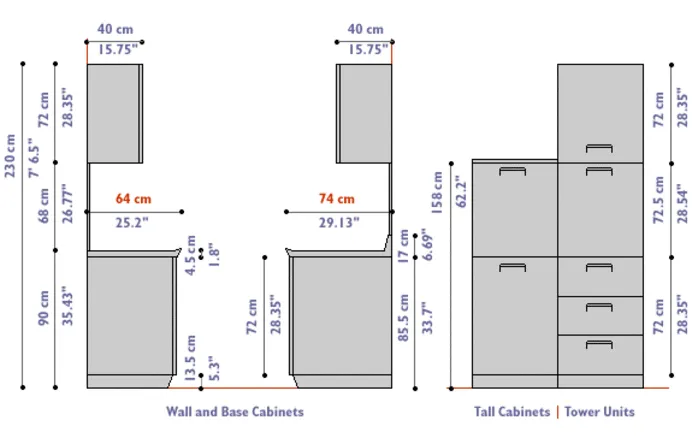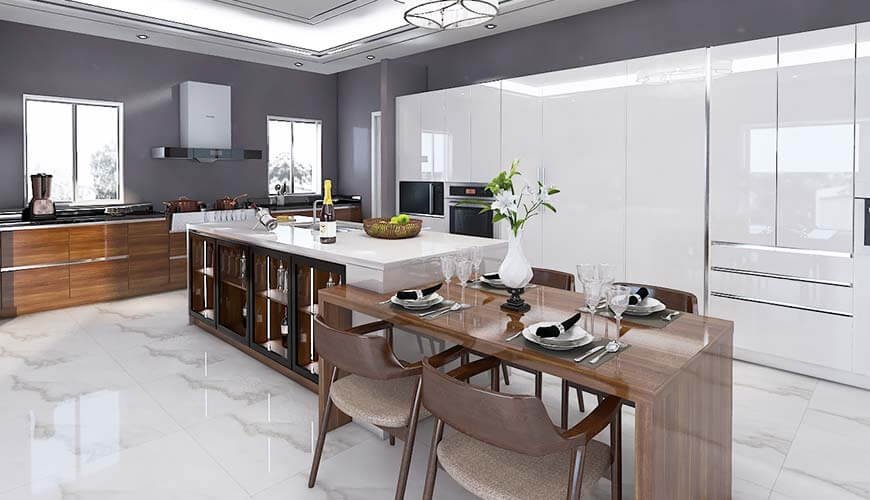Standard kitchen cabinets are typically 24 inches deep and 36 inches tall. Their width can vary from 9 to 48 inches.
Kitchen cabinets are essential in every home, offering storage and enhancing functionality. They come in various sizes to fit different kitchen layouts. The standard depth is usually 24 inches, while the height is often 36 inches. Widths can range from 9 to 48 inches, providing flexibility for diverse kitchen designs.
Accurate measurements are crucial to ensure a perfect fit and efficient space utilization. Choosing the right width and configuration can significantly impact the kitchen’s overall appearance and usability. Whether you prefer a sleek modern look or a traditional style, selecting the appropriate cabinet size is vital for a well-organized kitchen.

Credit: www.kitchen-design-nyc.com
Table of Contents
ToggleStandard Cabinet Widths
Understanding the standard cabinet widths is essential when planning a kitchen layout. Cabinets come in various sizes to suit different needs and spaces. Knowing these dimensions helps ensure a functional and aesthetically pleasing kitchen.
Base Cabinets
Base cabinets are the foundation of your kitchen. They rest on the floor and support countertops and sinks. The standard widths for base cabinets range between 9 inches and 48 inches. Typically, they increase in increments of 3 inches. This allows for flexibility in kitchen design.
| Width (in inches) | Common Use |
|---|---|
| 9 – 18 | Filler spaces and small storage |
| 21 – 24 | Standard storage and small appliances |
| 27 – 30 | Drawers and larger storage |
| 33 – 48 | Under the sink and large cabinets |
Wall Cabinets
Wall cabinets are mounted on the wall and provide upper storage. They are essential for storing dishes, glassware, and other kitchen items. The standard widths for wall cabinets also vary between 9 inches and 48 inches, increasing in 3-inch increments.
- 9 – 12 inches: Good for spice racks and small items.
- 15 – 18 inches: Suitable for dishware and glass storage.
- 21 – 24 inches: Ideal for larger dishware and small appliances.
- 27 – 30 inches: Great for bulkier kitchen items.
- 33 – 48 inches: Perfect for larger storage needs.
Choosing the right cabinet widths ensures a well-organized and efficient kitchen. Proper planning makes cooking and storing items easier and more enjoyable.
:max_bytes(150000):strip_icc()/guide-to-common-kitchen-cabinet-sizes-1822029-base-6d525c9a7eac49728640e040d1f90fd1.png)
Credit: www.thespruce.com
Custom Vs. Stock Cabinets
Choosing between custom and stock kitchen cabinets can be challenging. Both options have distinct advantages. This section explores the benefits and affordability of each type.
Benefits Of Custom Widths
Custom cabinets offer flexibility in width and design. You can get cabinets that fit perfectly in your kitchen space. Here are some key benefits:
- Tailored Fit: Custom widths ensure a seamless fit in any kitchen layout.
- Unique Design: Choose designs that match your style and needs.
- Higher Quality: Custom cabinets often use superior materials and craftsmanship.
- Maximized Space: Custom widths help utilize every inch of your kitchen effectively.
Affordability Of Stock Options
Stock cabinets are pre-made and come in standard widths. They are a popular choice for budget-conscious homeowners. Here are the main advantages:
- Cost-Effective: Stock cabinets are generally cheaper than custom cabinets.
- Quick Availability: These cabinets are readily available and reduce wait time.
- Standard Sizes: Stock cabinets come in widths that fit most kitchen spaces.
- Variety: Despite being pre-made, they come in various styles and finishes.
Measuring Your Space
Understanding the width of kitchen cabinets is crucial for a perfect fit. First, you need to measure your space accurately. This ensures your new cabinets fit seamlessly. Follow our guide for precise measurements.
Tools Needed
- Measuring tape
- Pencil
- Paper
- Level
- Step stool (if needed)
Step-by-step Guide
- Clear the area: Remove any items blocking the space.
- Measure the width: Use the measuring tape to measure from one wall to the other.
- Mark the measurements: Write down the width on your paper.
- Check the height: Measure from the floor to the ceiling.
- Note obstacles: Identify any vents, pipes, or windows in the space.
- Double-check your measurements: Ensure all numbers are accurate.
Here is a quick reference table for standard kitchen cabinet widths:
| Type of Cabinet | Standard Width (in inches) |
|---|---|
| Base Cabinets | 24″ |
| Wall Cabinets | 12″ – 36″ |
| Tall Cabinets | 12″ – 24″ |
By following these steps, you can measure your space accurately. This helps in choosing the right kitchen cabinets. Happy measuring!
Choosing The Right Width
Deciding the width of kitchen cabinets is crucial. It influences both design and functionality. The right width optimizes space and enhances kitchen efficiency.
Kitchen Layout Considerations
The kitchen layout determines cabinet width. Galley kitchens may need narrower cabinets. L-shaped kitchens can accommodate wider options. Consider the room’s flow and space.
Avoid cramped spaces. Ensure ease of movement. Plan for appliances and work zones. The layout should support your cooking habits.
Functionality Needs
Think about your storage needs. Do you store large pots and pans? Wider cabinets help. For spices and small items, narrower cabinets work best.
Evaluate your daily tasks. Do you bake often? A wider cabinet for baking trays is useful. Do you need pantry space? Consider tall, narrow cabinets.
List your essential kitchen items. Match them to cabinet sizes. This ensures everything fits perfectly.
Impact On Storage
The width of kitchen cabinets plays a crucial role in storage efficiency. Wider cabinets offer more space, making it easier to store larger items. They also help in organizing kitchen essentials better, reducing clutter.
Optimizing Space
Optimizing space in your kitchen starts with cabinet width. Standard widths range from 12 to 48 inches. Wider cabinets can accommodate more items, making it easier to find what you need.
| Cabinet Width | Storage Benefits |
|---|---|
| 12 inches | Ideal for spices and small jars |
| 24 inches | Great for pots and pans |
| 36 inches | Perfect for larger appliances |
- 12-inch cabinets are perfect for narrow spaces.
- 24-inch cabinets offer moderate storage for medium-sized items.
- 36-inch cabinets provide ample space for large kitchen items.
Choosing the right width ensures everything has its place. This helps in maintaining a clean and organized kitchen.
Specialty Cabinets
Specialty cabinets can further enhance storage solutions. These cabinets are designed for specific items, making them highly efficient.
- Corner cabinets utilize otherwise wasted space.
- Pull-out shelves offer easy access to items.
- Lazy Susans make reaching items in the back simple.
Corner cabinets often come with rotating shelves. This feature maximizes the use of hard-to-reach areas.
Pull-out shelves are perfect for deep cabinets. They make it easy to see and reach all stored items.
Lazy Susans are ideal for corner cabinets. They allow you to spin the shelf to access items at the back.
Common Mistakes
Designing a kitchen involves many decisions. One important decision is the width of kitchen cabinets. Many people make common mistakes that can affect the functionality and appearance of their kitchen. Below, we explore some of these common mistakes.
Ignoring Appliance Size
One major mistake is ignoring the size of appliances. Each appliance needs its own space. For example, a refrigerator needs more space than a standard cabinet. If you ignore this, you may have uneven gaps or crowded spaces.
Always measure your appliances first. Make sure there is enough room for them. This ensures a smoother and more functional kitchen layout.
Overlooking Traffic Flow
Another common mistake is overlooking traffic flow. People need to move easily in the kitchen. If cabinets are too wide, they can block pathways. This can make the kitchen feel cramped and uncomfortable.
Consider the space between cabinets and other elements. Ensure there is enough room for people to walk and work. This creates a more enjoyable and functional kitchen space.
| Common Mistake | Impact |
|---|---|
| Ignoring Appliance Size | Uneven gaps, crowded spaces |
| Overlooking Traffic Flow | Cramped, uncomfortable kitchen |
By avoiding these mistakes, you can achieve a well-designed kitchen. Always consider appliance size and traffic flow for the best results.
Trends In Cabinet Widths
Kitchen cabinets are essential for storage and style. Choosing the right width is crucial for functionality and aesthetics. Let’s dive into the latest trends in cabinet widths.
Popular Designs
Popular designs reflect current tastes and needs. Here’s a look at what’s trending:
- Standard Widths: Most cabinets are 12, 24, or 36 inches wide.
- Custom Sizes: Custom widths offer flexibility for unique spaces.
- Slim Cabinets: Slim cabinets, 9-12 inches wide, fit small kitchens.
- Wide Drawers: Drawers up to 48 inches wide are gaining popularity.
Future Predictions
Future trends will likely focus on functionality and sustainability. Here’s what experts predict:
- Modular Systems: Modular cabinets with adjustable widths will be popular.
- Eco-friendly Materials: Use of sustainable materials will increase.
- Smart Storage: Cabinets with built-in smart technology will be trending.

Credit: www.bkciandre.com
Expert Tips
When designing or remodeling a kitchen, the width of kitchen cabinets is crucial. Understanding the standard dimensions helps in planning a functional and beautiful space. Here are some expert tips to guide you.
Consulting A Professional
Consulting a professional can save time and money. An expert can provide insights into the best cabinet widths for your kitchen layout. They can also help with custom designs that meet your specific needs.
Professionals have access to the latest trends and materials. They ensure your kitchen is both stylish and practical. Here are some benefits of consulting a professional:
- Accurate measurements: Avoid costly mistakes.
- Expert advice: Get recommendations based on experience.
- Quality assurance: Ensure the use of high-quality materials.
Hiring a professional can streamline the process and ensure a perfect fit for your cabinets.
Diy Tips
For those who enjoy DIY projects, measuring and installing kitchen cabinets can be rewarding. Here are some tips to help you get started:
- Measure accurately: Use a tape measure to get precise dimensions.
- Standard widths: Most cabinets come in widths of 12, 15, 18, 24, 30, 33, and 36 inches.
- Plan your layout: Sketch your kitchen to see where each cabinet will go.
- Use quality tools: Ensure you have the right tools for the job.
DIY projects can be fun and cost-effective. Just make sure to follow these tips for the best results.
Frequently Asked Questions
What Are Standard Kitchen Cabinet Widths?
Standard widths range from 9 to 48 inches in 3-inch increments.
How Wide Are Base Kitchen Cabinets?
Base cabinets typically range from 12 to 48 inches wide.
What Is The Width Of Upper Cabinets?
Upper cabinets are usually 12 to 36 inches wide.
Are Custom Cabinet Widths Available?
Yes, custom widths can be made to fit your space.
What Width For Pantry Cabinets?
Pantry cabinets often range from 12 to 36 inches wide.
How Wide Are Corner Kitchen Cabinets?
Corner cabinets are usually 33 to 36 inches wide.
What Is The Narrowest Kitchen Cabinet Width?
The narrowest kitchen cabinets start at 9 inches wide.
What Width For Sink Base Cabinets?
Sink base cabinets are typically 30 to 36 inches wide.
How Wide Are Drawer Base Cabinets?
Drawer base cabinets range from 12 to 36 inches wide.
Do Cabinet Widths Affect Kitchen Design?
Yes, cabinet widths significantly impact kitchen functionality and layout.
Conclusion
Understanding the standard widths of kitchen cabinets can simplify your renovation project. Proper planning ensures efficient use of space. Always measure your kitchen area before purchasing cabinets. This helps avoid costly mistakes and ensures a perfect fit. With these tips, your kitchen will be both functional and stylish.


